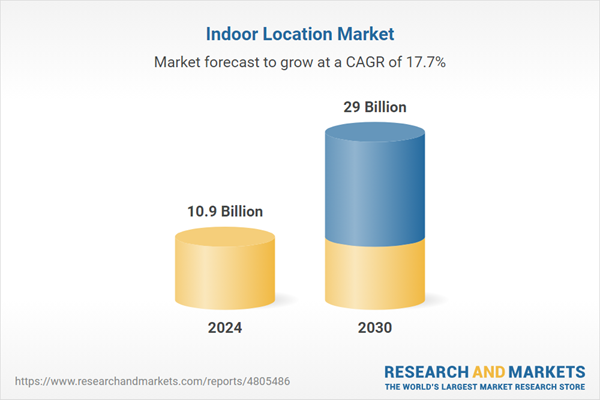Global Indoor Location Market - Key Trends & Drivers Summarized
Why Is Indoor Location Technology Emerging as a Cornerstone of Smart Infrastructure?
Indoor location systems are rapidly gaining prominence as essential components of modern buildings, smart facilities, and connected public spaces. Unlike outdoor GPS-based navigation, indoor location technologies are designed to offer precise tracking and guidance within enclosed environments such as malls, airports, hospitals, warehouses, and office buildings. This shift toward real-time indoor positioning is being driven by growing demand for seamless user experiences, operational efficiency, and spatial intelligence. The ability to locate people, assets, or products within complex structures helps organizations optimize space utilization, monitor movement patterns, and improve safety. In retail, for instance, indoor location systems can guide shoppers to specific items, enhance targeted marketing, and streamline inventory management. Hospitals are leveraging the technology to track equipment, locate personnel, and reduce patient wait times. Airports and transit hubs use it to direct travelers, manage foot traffic, and enhance security. The applications extend further into education, entertainment, and even emergency response, where accurate indoor positioning can make a critical difference. As businesses and public institutions adopt digital transformation strategies, indoor location systems are becoming key enablers of connected environments that adapt to real-time data. This growing relevance marks indoor location as a foundational layer for building smarter, safer, and more efficient infrastructure.How Are Innovations in Positioning Methods and Sensor Fusion Enhancing Accuracy?
Technological advancements in positioning algorithms, sensor fusion, and connectivity protocols are dramatically improving the reliability and precision of indoor location systems. While GPS performs poorly inside buildings due to signal interference and lack of satellite visibility, alternative technologies such as Bluetooth Low Energy (BLE), Wi-Fi, Ultra-Wideband (UWB), Li-Fi, and geomagnetic sensors are being deployed to fill the gap. These systems often work in combination, using hybrid models that enhance location accuracy by triangulating data from multiple sources. UWB, for example, offers centimeter-level precision and is being increasingly used in environments where accuracy is paramount, such as industrial automation and robotics. BLE beacons are cost-effective and widely adopted in commercial settings, providing room-level visibility and real-time updates. Integration with smartphone sensors such as accelerometers, gyroscopes, and barometers enables location estimation even when external signals are weak or unavailable. The rise of artificial intelligence and machine learning is further enhancing performance by enabling predictive modeling and real-time calibration based on environmental changes. Mapping platforms are evolving to support 3D indoor environments with dynamic floor plans, while cloud computing facilitates scalable data processing and remote system management. These technical innovations are making indoor location systems not only more accurate but also more adaptive and customizable for diverse operational needs.What Role Are User Experience and Operational Insights Playing in Market Adoption?
As industries and institutions prioritize user-centric design and data-driven decision-making, indoor location technologies are being recognized for their dual ability to improve end-user experiences and deliver actionable insights. In consumer-facing environments such as retail and hospitality, indoor positioning systems enable personalized experiences by guiding visitors, sending location-based promotions, and offering real-time service updates. In large venues like convention centers and stadiums, digital wayfinding solutions help attendees navigate efficiently, reducing confusion and enhancing satisfaction. Simultaneously, businesses are using indoor location data to understand behavioral trends, analyze crowd flow, and evaluate space utilization. Facilities managers can make more informed decisions about layout redesigns, traffic control, and cleaning schedules by studying movement patterns over time. In logistics and manufacturing, indoor tracking of assets, tools, and inventory ensures that operations remain lean and efficient, reducing downtime and loss. Healthcare providers are using these systems to optimize staff allocation and equipment usage, enhancing both care quality and resource management. Integration with mobile apps and wearable devices also extends functionality, allowing users to access location-based services through familiar platforms. The convergence of user engagement and operational analytics is driving broader adoption, as organizations realize the strategic value of indoor location beyond mere navigation.What Factors Are Driving the Rapid Growth of the Indoor Location Market Globally?
The growth of the indoor location market is being propelled by a confluence of technology trends, industry needs, and regulatory pressures that are reshaping how physical spaces are designed and managed. A key growth driver is the widespread push toward digital transformation across sectors including retail, healthcare, transportation, education, and manufacturing. As organizations look to digitize their physical spaces, indoor positioning systems are becoming vital tools for enabling real-time connectivity and automation. The proliferation of smart buildings and Internet of Things (IoT) devices is also accelerating adoption, as these systems require precise location awareness to function effectively. In urban environments, the need for smarter mobility, public safety, and emergency response has increased demand for high-resolution indoor maps and navigation systems. Government initiatives focused on smart cities and infrastructure modernization are further supporting this expansion. Additionally, the pandemic heightened awareness of crowd management and contact tracing capabilities, leading to greater investment in location-based safety solutions. Businesses are recognizing that indoor location technologies can help ensure compliance with social distancing, evacuation protocols, and asset traceability regulations. The increasing availability of scalable, cloud-based platforms and open APIs is lowering the barrier to entry for organizations of all sizes. As these systems continue to mature and demonstrate ROI, they are becoming indispensable tools in the design and operation of intelligent, responsive environments. This growing reliance is expected to fuel sustained global expansion of the indoor location market across a wide spectrum of industries and use cases.Scope Of Study:
The report analyzes the Indoor Location market in terms of units by the following Segments, and Geographic Regions/Countries:Segments: Component (Hardware Component, Software Component, Services Component); Technology (Tags Technology, Nodes Technology, Ultra-Wideband Technology, Bluetooth Technology, Wi-Fi Technology, Visible Light Communication Technology, Radiofrequency Identification Technology); Deployment (On-Premise Deployment, Cloud Deployment); Application (Remote Monitoring Application, Customer Experience Management Application, Inventory Management Application, Emergency Response Management Application, Sales & Marketing Optimization Application, Risk Management Application, Predictive Asset Analytics Application, Other Applications); Vertical (Hospitality Vertical, Retail Vertical, Transportation & Logistics Vertical, Entertainment Vertical, Public Buildings Vertical, Manufacturing Vertical, Other Verticals)
Geographic Regions/Countries: World; United States; Canada; Japan; China; Europe (France; Germany; Italy; United Kingdom; Spain; Russia; and Rest of Europe); Asia-Pacific (Australia; India; South Korea; and Rest of Asia-Pacific); Latin America (Argentina; Brazil; Mexico; and Rest of Latin America); Middle East (Iran; Israel; Saudi Arabia; United Arab Emirates; and Rest of Middle East); and Africa.
Key Insights:
- Market Growth: Understand the significant growth trajectory of the Hardware Component segment, which is expected to reach US$16.4 Billion by 2030 with a CAGR of a 18.8%. The Software Component segment is also set to grow at 15.2% CAGR over the analysis period.
- Regional Analysis: Gain insights into the U.S. market, estimated at $3.0 Billion in 2024, and China, forecasted to grow at an impressive 24.2% CAGR to reach $6.8 Billion by 2030. Discover growth trends in other key regions, including Japan, Canada, Germany, and the Asia-Pacific.
Why You Should Buy This Report:
- Detailed Market Analysis: Access a thorough analysis of the Global Indoor Location Market, covering all major geographic regions and market segments.
- Competitive Insights: Get an overview of the competitive landscape, including the market presence of major players across different geographies.
- Future Trends and Drivers: Understand the key trends and drivers shaping the future of the Global Indoor Location Market.
- Actionable Insights: Benefit from actionable insights that can help you identify new revenue opportunities and make strategic business decisions.
Key Questions Answered:
- How is the Global Indoor Location Market expected to evolve by 2030?
- What are the main drivers and restraints affecting the market?
- Which market segments will grow the most over the forecast period?
- How will market shares for different regions and segments change by 2030?
- Who are the leading players in the market, and what are their prospects?
Report Features:
- Comprehensive Market Data: Independent analysis of annual sales and market forecasts in US$ Million from 2024 to 2030.
- In-Depth Regional Analysis: Detailed insights into key markets, including the U.S., China, Japan, Canada, Europe, Asia-Pacific, Latin America, Middle East, and Africa.
- Company Profiles: Coverage of players such as Accuware, AiRISTA Flow, Apple Inc., Blueiot Technology Co., Ltd, CenTrak and more.
- Complimentary Updates: Receive free report updates for one year to keep you informed of the latest market developments.
Some of the 44 companies featured in this Indoor Location market report include:
- Accuware
- AiRISTA Flow
- Apple Inc.
- Blueiot Technology Co., Ltd
- CenTrak
- Cisco Systems, Inc.
- Esri
- Geosparc
- HERE Technologies
- Inpixon
- Mist Systems (Juniper)
- Navigine
- Nextome
- NVIDIA (Indoor Mapping AI)
- Polestar Technologies
- Quuppa
- Sensewhere Ltd
- Sewio Networks
- Ubisense Limited
- Zebra Technologies
This edition integrates the latest global trade and economic shifts as of June 2025 into comprehensive market analysis. Key updates include:
- Tariff and Trade Impact: Insights into global tariff negotiations across 180+ countries, with analysis of supply chain turbulence, sourcing disruptions, and geographic realignment. Special focus on 2025 as a pivotal year for trade tensions, including updated perspectives on the Trump-era tariffs.
- Adjusted Forecasts and Analytics: Revised global and regional market forecasts through 2030, incorporating tariff effects, economic uncertainty, and structural changes in globalization. Includes segmentation by product, technology, type, material, distribution channel, application, and end-use, with historical analysis since 2015.
- Strategic Market Dynamics: Evaluation of revised market prospects, regional outlooks, and key economic indicators such as population and urbanization trends.
- Innovation & Technology Trends: Latest developments in product and process innovation, emerging technologies, and key industry drivers shaping the competitive landscape.
- Competitive Intelligence: Updated global market share estimates for 2025, competitive positioning of major players (Strong/Active/Niche/Trivial), and refined focus on leading global brands and core players.
- Expert Insight & Commentary: Strategic analysis from economists, trade experts, and domain specialists to contextualize market shifts and identify emerging opportunities.
- Complimentary Update: Buyers receive a free July 2025 update with finalized tariff impacts, new trade agreement effects, revised projections, and expanded country-level coverage.
Table of Contents
Companies Mentioned (Partial List)
A selection of companies mentioned in this report includes, but is not limited to:
- Accuware
- AiRISTA Flow
- Apple Inc.
- Blueiot Technology Co., Ltd
- CenTrak
- Cisco Systems, Inc.
- Esri
- Geosparc
- HERE Technologies
- Inpixon
- Mist Systems (Juniper)
- Navigine
- Nextome
- NVIDIA (Indoor Mapping AI)
- Polestar Technologies
- Quuppa
- Sensewhere Ltd
- Sewio Networks
- Ubisense Limited
- Zebra Technologies
Table Information
| Report Attribute | Details |
|---|---|
| No. of Pages | 605 |
| Published | January 2026 |
| Forecast Period | 2024 - 2030 |
| Estimated Market Value in 2024 | 10.9 Billion |
| Forecasted Market Value by 2030 | 29 Billion |
| Compound Annual Growth Rate | 17.7% |
| Regions Covered | Global |









